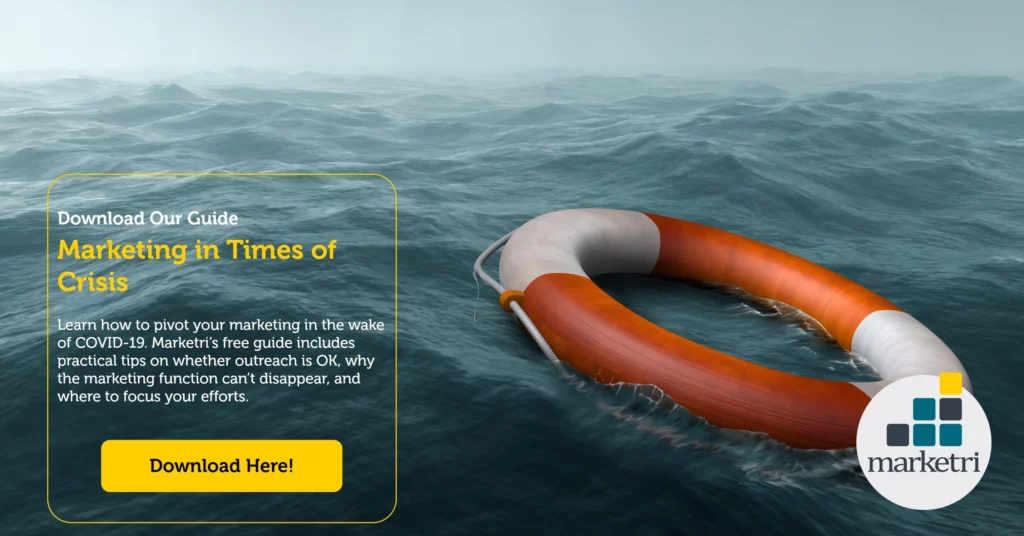How to Set Marketing Priorities to Drive Your Marketing Rollout Plan
We are in a new world—a sudden shift and a sustained uncertainty.
I don’t have to tell you that; you already know it. It’s in the way you navigate
your surroundings. The way you wash your hands. The way you look out the
window.
As marketers, it presents an awkward reality. We’re makers, explainers, connectors of dots, broadcasters, promoters. What do we shout from the rooftops now? Does it matter? Is anyone even listening?
I don’t know. Maybe. Hopefully.
But here’s what I do know: We can still move forward. It’s possible to reset priorities and execute a smart marketing rollout plan to create impact. And if you’re lost in terms of how to do that, then it’s worth taking a few steps back to the fundamentals.
What are your core strengths?
Often, as B2B companies grow, so does the complexity of their offerings. They expand their services, industries, and specialties on the path toward becoming all things to all people. The fear of a missed opportunity drives a focus on breadth and coverage, rather than depth.
It might seem simplistic, but before you create your marketing rollout plan, you should reassess where you have real depth. Revisiting company strengths is important to keeping in mind what you can deliver to customers. You’ll need that knowledge to take the most advantage of the opportunities before you.
What are your biggest opportunities?
If you are clear on your strengths, the next step is choosing where to apply them. From a marketing perspective, the Coronavirus pandemic has created a business environment in which business leaders can almost better presume the pains and needs of their target buyers.
In a sense, the universality in the level of disruption has almost created more clarity in how to reach buyers with a key message.
The exercise of thinking through customer/prospect needs and business opportunities can dictate changes to items that may have been set in stone six months ago. For example, you might find your marketing rollout plan has a new:
- Target Buyer
- Highest-Priority Industry
- Company’s Messaging
- Overall Outreach Strategy
Those types of changes are nothing to be afraid of. If you’ve documented where you’re likely to drive the most business, it makes the path forward clearer. You know what you do best and who can benefit most from it—so it’s now a matter of connecting those two things.
What do we have to work with?
Rollout involves a certain measure of tactical flexibility, and I think it’s best to think about this as a balance of three variables: budget, people, and tools.
Budget sets a constraint, and creates an inherent focusing of effort. The people you have on hand to drive your marketing rollout plan—and their capabilities, strengths, and collaborative impact—will determine pace, tactics, and realistic expectations.
The tools to employ should be considered in terms of time to impact. In other words, which tools and tactics can you deploy quickly, and which will take more time to generate results? Part of the complexity here is understanding what doesn’t make sense to change, what you already have on hand that you can adjust and reuse, and how much of a pivot you truly need to make. But in the case that you need to shift your marketing priorities drastically, the ordering might look something like this, from first ball rolling to last:
- PPC Build
- Website Changes/Messaging
- Service Sheets
- Social Media Outreach
- New Blogs and Content
- Email Campaigns
To encourage pace, set the quality bar somewhere around 80% to pixel perfect. Your best shot is good enough to get started, and rather than letting the last 20% slow you down, plan on revisiting when you have data that can inform the updates.
What can we measure?
New circumstances and new targets mean new outcomes. Even if you’re sitting on years of data, it’s important to be aware that a drastic shift can make that data irrelevant. As you roll out your new marketing tactics, take extra care in tagging, tracking, and labeling. Focus on getting to some sort of sense, some sort of insight to inform the next decision. Create simple models that can help you get from best guess to data-driven choice.
What can we invest in?
Do not lose sight of smart long-term investments due to the pace of the near-term sprint. Not everything you make today needs to be in service to the near-term target.
Make sure you put something away for a sunny day, that you’re thinking ahead to moving forward more strategically in the new normal. That might be writing a blog now for six months down the road. Or leveraging available subject matter experts to fill your content coffers. Or taking the time to go through your contact database or marketing automation setup to add new fields or clean up your data.

You can be nimble and impactful now, but don’t lose sight of the future. It’s coming either way, and even if you can’t count on specifics, you can still commit to actions that will pay dividends later.
Learn More About Creating a Marketing Rollout Plan
If you’re trying to forge a path forward and create strong marketing in a crisis, then we invite you to download our free guide, which has thoughtful tips and best practices:






